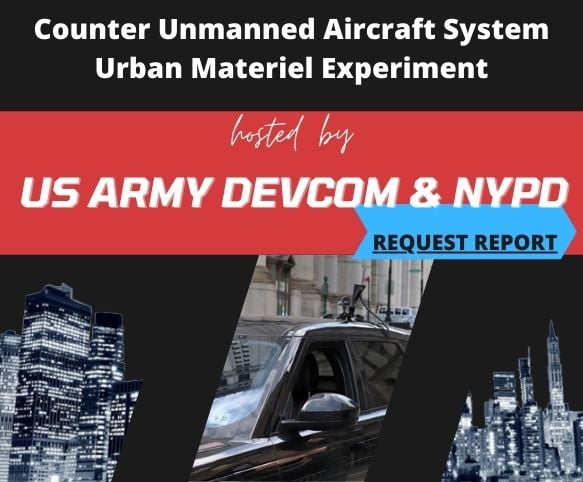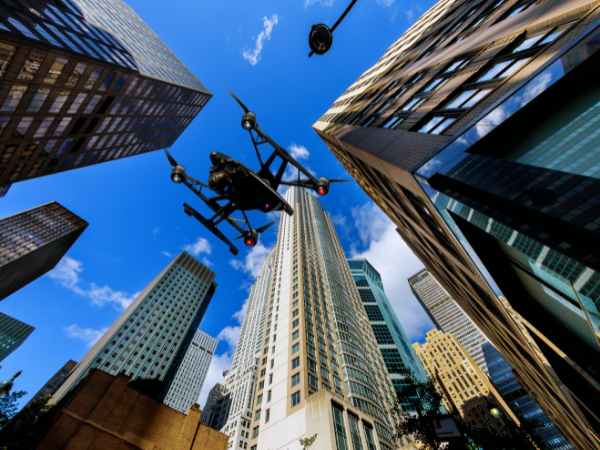Drones pose a potential threat to public safety in any environment, each with its own challenges for their pilots. For example, in rural or desert-like conditions, drones can typically fly much farther from their controllers than in an urban setting because of the wide open space.
In urban conditions, the range is significantly reduced by the buildings causing reflections, Line of Sight (LOS) restrictions, and increased Radio Frequency (RF) transmissions due to things like WiFi access points and cell phones. While these are challenges for drone pilots, they also impose similar restrictions on drone detection solutions.
Which Type of Drone Detection Sensor is Best in Urban Areas?
According to the Federal Aviation Administration, there are two primary technologies for detecting drones, Radio Detection And Ranging (RADAR) and RF. Acoustic and camera technologies are considered secondary and are very limited in an urban environment.
| Acoustic (Secondary) | Camera (Secondary) |
| Acoustic sensors struggle to deal with the constantly changing noise level and traffic patterns. | Cameras are restricted by LOS and typically require many in order to cover an area. Existing camera infrastructure tends to be aimed downwards to monitor ground activities which doesn't account for the aerial threat of a drone. |
| RADAR (Primary) |
|
| RADAR also operates by LOS, meaning it cannot detect through or around objects in the environment. In this case, the RADAR system must be installed so that it has an unobstructed view of the target coverage area, usually at the top of tall buildings in a city. RADAR typically transmits in a cone. For example, a RADAR antenna may only look at a 60 degree inclination, meaning it looks up 30 degrees and down 30 degrees, or maybe it’s tilted to look up for the drones and it looks up 40 degrees and down 20 degrees. However, this means something can fly above or below the RADAR coverage area and evade detection. Typically the blind angles are mitigated by the long range of the RADAR, but in an urban environment, elevated sensor installations plus surrounding tall buildings and various obstructions restrict the range of the RADAR, only enhancing one of its biggest weaknesses. |
|
| RF (Primary) | |
| RF detection technology is very well suited for urban drone detection. There are still many challenges for RF detection within urban environments, however they can be overcome. RF detection does not require LOS, though like RADAR, it will not detect through large buildings. Therefore it can detect through much of the ground clutter and traffic expected within urban settings. RF drone detection systems will have to compensate for the increased amount of RF traffic in a city which is very feasible as long as the system is designed to do so and was not built and/or tested in rural/desert operation only. Another challenge is the signal reflections off of buildings and various objects within the environment, also known as multipath. Some RF systems can compensate for multipath if they are designed for urban use. |
|
How Many Drone Detection Sensors are Best in Urban Areas?
Since RF is better suited for urban environments than RADAR, the next major question is how many RF sensors does it take? To answer this, it’s important to understand where sensors should be placed.
-
-
- Typically elevated positions with clear LOS to the coverage area are preferred. The sensors can be anywhere from ground level to the tops of the buildings. Areas like street corners or intersections provide decent LOS in many directions. Sensors should not be installed in places with extremely high RF emissions such as a city hall rooftop with the city’s emergency communications equipment.
-
-
-
- Additionally, it’s important to make sure the installation location meets the sensor’s needs such as available power and network connectivity. Bulky, power hungry sensors may be difficult to deploy physically, and building owners may not allow them for aesthetic reasons. Furthermore, many tall buildings in cities are above the LTE coverage, as that network is transmitted down towards the ground.
-
-
-
- The final consideration for the amount of sensors required is the size and shape of the coverage area. For this it’s best to work with a trusted manufacturer to get a clear understanding of how many sensors cover a set area. As a rule of thumb, the sensors should be laid out in their preferred spacing from each other as best as possible with the installation restrictions. A remote site survey and onsite survey to confirm sensor placements should be a part of any installation process.
-
For permanent coverage of an area within a city block, four or five fixed sensors is likely sufficient, but this is highly dependent on the use case and topology of the area. If the coverage area is large or strangely shaped, more sensors will be needed.
Systems that claim to only need one sensor in the same environment are very likely violating federal privacy laws by decoding and demodulating (commonly known as “hacking”) the signal between the drone and controller to extract information. Even simply reading the GPS from the drones will likely require more than one sensor due to blind spots and obstructions in urban environments.
If the coverage area includes urban canyons that cannot be easily covered with the fixed sensor installation, a mobile sensor is an extremely useful option. The mobile sensor can work in conjunction with the fixed sensors and dynamically adjust the system’s coverage as needed. Because RF does not require LOS, systems will likely alert (with reduced accuracy) even if devices are within a “blind spot” and a vehicle-based sensor can be dispatched to mitigate the “blind spot” and accurately detect and locate the device.
 AeroDefense AirWarden Temporary/Portable Unit set up during NYC materiel experiment
AeroDefense AirWarden Temporary/Portable Unit set up during NYC materiel experiment
Last October the US ARMY Combat Capabilities Development Command (DEVCOM) and New York Police Department (NYPD) invited AeroDefense to provide its mobile drone detection capabilities during their Subterranean/Dense Urban Community of Practice: Counter Unmanned Aircraft System Materiel Experiment in Lower Manhattan. The experiment took place over the course of two (2) days. The host agencies flew several different types of drones which varied in size to see how the participating vendors’ systems would perform in the tough urban environment. Flight paths varied in attempts to evade detection. The agencies produced a report describing challenges of deploying in an urban environment, lessons learned and more.

|
|


